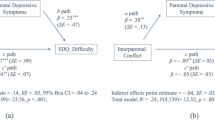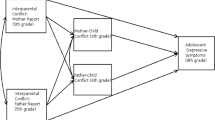Abstract
Parent–adolescent conflict is frequent in families and has implications for youth adjustment and family relationships. Drawing on a family systems perspective, we examined mothers’, fathers’, and two adolescent-aged siblings’ (50.5 % females) reports of parent–adolescent conflict in 187 African American families. Using latent profile analysis in the context of an ethnic homogeneous design, we identified three family types based on levels of and differences between parent and youth conflict reports: low conflict, father high conflict, and younger sibling high conflict. Compared to low conflict families, youth in younger sibling high conflict families reported more depressive symptoms and risky behaviors. The results for parents’ acceptance revealed that, in comparison to low conflict families, older siblings in father high conflict families reported lower acceptance from mothers, and mothers in these families reported lower acceptance of their children; further, older siblings in younger sibling high conflict families reported less acceptance from fathers, and fathers in these families reported less acceptance of their children. Results underscore the significance of levels of and both differences between and direction of differences in parents’ and youth’s reports of their “shared” experiences, as well as the importance of examining the larger family contexts of dyadic parent-relationships.




Similar content being viewed by others
References
Coley, R. L., & Chase-Landsdale, P. L. (1999). Stability and change in paternal involvement among urban African American fathers. Journal of Family Psychology, 13, 416–435. doi:10.1037/0893-3200.13.3.416.
Coll, C. G., Lamberty, G., Jenkins, R., McAdoo, H. P., Crnic, K., Wasik, B. H., & Garcia, H. V. (1996). An integrative model for the study of developmental competencies in minority children. Child Development, 67, 1891–1914. doi:10.2307/1131600.
Cox, M. J., & Paley, B. (1997). Families as systems. Annual Review of Psychology, 48, 243–267. doi:10.1146/annurev.psych.48.1.243.
De Los Reyes, A., Goodman, K. L., Kliewer, W., & Reid-Quinones, K. (2010). The longitudinal consistency of mother–child reporting discrepancies of parental monitoring and their ability to predict child delinquent behaviors two years later. Journal of Youth and Adolescence, 39, 1417–1430. doi:10.1007/s10964-009-9496-7.
De Los Reyes, A., Ohannessian, C. M., & Laird, R. D. (2016). Developmental changes in discrepancies between adolescents’ and their mothers’ views of family communication. Journal of Child and Family Studies, 3(25), 790–797. doi:10.1007/s10826-015-0275-7.
Dotterer, A. M., Lowe, K., & McHale, S. M. (2014). Academic growth trajectories and family relationships among African American youth. Journal of Research on Adolescence, 24, 734–747. doi:10.1111/jora.12080.
Eccles, J., & Barber, B. (1990). The risky behavior scale. Unpublished measure, The University of Michigan.
Ehrlich, K. B., Cassidy, J., & Dykas, M. J. (2011). Reporter discrepancies among parents, adolescents, and peers: Adolescent attachment and informant depressive symptoms as explanatory factors. Child Development, 82, 999–1012. doi:10.1111/j.1467-8624.2010.01530.x.
Ehrlich, K. B., Richards, J. M., Lejuez, C. W., & Cassidy, J. (2015). When parents and adolescents disagree about disagreeing: Observed parent–adolescent communication predicts informant discrepancies about conflict. Journal of Research on Adolescence,. doi:10.1111/jora.12197.
Feldman, S. S., Wentzel, K. R., & Gehring, T. M. (1989). A comparison of the views of mothers, fathers, and pre-adolescents about family cohesion and power. Journal of Family Psychology, 3, 39–60. doi:10.1037/h0080523.
Gaylord, N. K., Kitzmann, K. M., & Coleman, J. K. (2003). Parents’ and children’s perceptions of parental behavior: Associations with children’s psychosocial adjustment in the classroom. Parenting: Science and Practice, 3(1), 23–47. doi:10.1207/S15327922PAR0301_02.
Gonzales, N. A., Cauce, A. M., & Mason, C. A. (1996). Interobserver agreement in the assessment of parental behavior and parent–adolescent conflict: African American mothers, daughters, and independent observers. Child Development, 67, 1483–1498. doi:10.1111/j.1467-8624.1996.tb01809.
Guion, K., Mrug, S., & Windle, M. (2009). Predictive value of informant discrepancies in reports of parenting: Relations to early adolescents’ adjustment. Journal of Abnormal Child Psychology, 37(1), 17–30. doi:10.1007/s10802-008-9253-5.
Holmbeck, G. N., & O’Donnell, K. (1991). Discrepancies between perceptions of decision making and behavioral autonomy. New Directions for Child and Adolescent Development, 51, 51–69. doi:10.1002/cd.23219915105.
Juang, L. P., Syed, M., & Takagi, M. (2007). Intergenerational discrepancies of parental control among Chinese American families: Links to family conflict and adolescent depressive symptoms. Journal of Adolescence, 30, 965–975. doi:10.1016/j.adolescence.2007.01.004.
Kovacs, M. (2001). Children’s Depression Inventory (CDI): Technical manual. New York: Multi-Health Systems.
Lanza, S. T., & Cooper, B. R. (2016). Latent class analysis for developmental research. Child Development Perspectives, 10, 59–64. doi:10.1111/cdep.12163.
Laursen, B., & Collins, A. W. (2009). Parent–adolescent relationships and influences. In R. M. Lerner & L. Steinberg (Eds.), Handbook of adolescent psychology (3rd ed., Vol. 2, pp. 3–42)., Contextual influences on adolescent development Hoboken, NJ: Wiley.
Magnusson, D. (2003). The person approach: Concepts, measurement models, and research strategy. New Directions for Child and Adolescent Development, 2003(101), 3–23. doi:10.1002/cd.79.
McLoyd, V. (1998). Changing demographics in the American population: Implications for research on minority children and adolescents. In V. C. McLoyd & L. Steinberg (Eds.), Studying minority adolescents: Conceptual, methodological, and theoretical issues (pp. 3–28). Mahwah, NJ: Erlbaum.
Minuchin, P. (1985). Families and individual development: Provocations from the field of family therapy. Child Development, 56, 289–302.
Muthén, L. K., & Muthén, B. O. (1998–2015). Mplus users’ guide (7th ed.). Los Angeles, CA: Muthén & Muthén.
Ohannessian, C. M., & De Los Reyes, A. (2014). Discrepancies in adolescents’ and their mothers’ perceptions of the family and adolescent anxiety symptomatology. Parenting, 14, 1–18. doi:10.1080/15295192.2014.870009.
Parke, R. D., & Buriel, R. (1998). Socialization in the family: Ethnic and ecological perspectives. In N. Eisenberg (Ed.), Handbook of Child Psychology (Vol. 3, pp. 463–552), Social, emotional, and personality development. New York, NY: Wiley.
Schwarz, J. C., Barton-Henry, M. L., & Pruzinsky, T. (1985). Assessing child-rearing behavior: A comparison of ratings made by mother, father, child, and sibling on the CRPBI. Child Development, 56, 462–479.
Shanahan, L., McHale, S. M., Osgood, D. W., & Crouter, A. C. (2007). Conflict frequency with mothers and fathers from middle childhood to late adolescence: Within-and between families comparisons. Developmental Psychology, 43(3), 539–550. doi:10.1037/0012-1649.43.3.539.
Smetana, J. G. (1988). Adolescents’ and parents’ conceptions of parental authority. Child Development, 59, 321–335.
Smetana, J. G., Daddis, C., & Chuang, S. S. (2003). “Clean your room!” A longitudinal investigation of adolescent–parent conflict and conflict resolution in middle-class African American families. Journal of Adolescent Research, 18, 631–650. doi:10.1177/0743558403254781.
Smetana, J., & Gaines, C. (1999). Adolescent–parent conflict in middle-class African American families. Child Development, 70, 1447–1463. doi:10.1111/1467-8624.00105.
Smetana, J. G., Metzger, A., & Campione-Barr, N. (2004). African American late adolescents’ relationships with parents: Developmental transitions and longitudinal patterns. Child Development, 75, 932–947. doi:10.1111/j.1467-8624.2004.00715.x.
Stuart, J., & Jose, P. E. (2012). The influence of discrepancies between adolescent and parent ratings of family dynamics on the well-being of adolescents. Journal of Family Psychology, 26, 858–868. doi:10.1037/a0030056.
Treutler, C. M., & Epkins, C. C. (2003). Are discrepancies among child, mother, and father reports on children’s behavior related to parents’ psychological symptoms and aspects of parent–child relationships? Journal of Abnormal Child Psychology, 31, 13–27. doi:10.1023/A:1021765114434.
Vermunt, J. K. (2010). Latent class modeling with covariates: Two improved three-step approaches. Political Analysis, 18, 450–469. doi:10.1093/pan/mpq025.
Weymouth, B. B., Buehler, C., Zhou, N., & Henson, R. A. (2016). A meta–analysis of parent–adolescent conflict: disagreement, hostility, and youth maladjustment. Journal of Family Theory & Review, 8, 95–112. doi:10.1111/jftr.12126.
Acknowledgments
We thank our project staff for their help in conducting this study and the participating families for their time and insights about their family lives.
Funding
This work was funded by a grant from the National Institute of Child Health and Human Development, R01-HD32336-02, Susan M. McHale and Ann C. Crouter, Co-Principal Investigators.
Authors’ Contributions
OS conceived of the study in collaboration with SM, OS performed the statistical analysis and drafted the manuscript; SM participated in the design of the study and interpretation of the data and helped to draft the manuscript. Both authors read and approved the final manuscript.
Author information
Authors and Affiliations
Corresponding author
Ethics declarations
Conflicts of Interest
The authors report no conflict of interests.
Ethical Approval
All procedures performed in studies involving human participants were in accordance with the ethical standards of the institutional and/or national research committee and with the 1964 Helsinki declaration and its later amendments or comparable ethical standards.
Informed Consent
Informed consent/assent was obtained from all individual participants included in the study.
Rights and permissions
About this article
Cite this article
Skinner, O.D., McHale, S.M. Parent–Adolescent Conflict in African American Families. J Youth Adolescence 45, 2080–2093 (2016). https://doi.org/10.1007/s10964-016-0514-2
Received:
Accepted:
Published:
Issue Date:
DOI: https://doi.org/10.1007/s10964-016-0514-2




